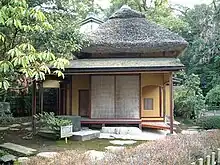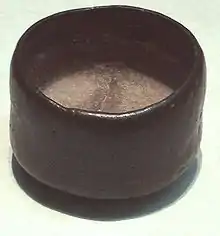Wabi-sabi
In traditional Japanese aesthetics, wabi-sabi (侘寂) is a world view centered on the acceptance of transience and imperfection.[2] The aesthetic is sometimes described as one of appreciating beauty that is "imperfect, impermanent, and incomplete" in nature.[3] It is prevalent in many forms of Japanese art.[4]



Wabi-sabi is a composite of two interrelated aesthetic concepts, wabi (侘) and sabi (寂). According to the Stanford Encyclopedia of Philosophy, wabi may be translated as "subdued, austere beauty," while sabi means "rustic patina."[5] Wabi-sabi is derived from the Buddhist teaching of the three marks of existence (三法印, sanbōin), specifically impermanence (無常, mujō), suffering (苦, ku) and emptiness or absence of self-nature (空, kū), however, the two were originally seen as distinct concepts.[6]
Characteristics of wabi-sabi aesthetics and principles include asymmetry, roughness, simplicity, economy, austerity, modesty, intimacy, and the appreciation of both natural objects and the forces of nature.
Description
According to Leonard Koren, wabi-sabi can be described as "the most conspicuous and characteristic feature of what we think of as traditional Japanese beauty. It occupies roughly the same position in the Japanese pantheon of aesthetic values as do the Greek ideals of beauty and perfection in the West." Another description of wabi-sabi by Andrew Juniper notes that, "If an object or expression can bring about, within us, a sense of serene melancholy and a spiritual longing, then that object could be said to be wabi-sabi."[7] For Richard Powell, "Wabi-sabi nurtures all that is authentic by acknowledging three simple realities: nothing lasts, nothing is finished, and nothing is perfect."[8]
The words wabi and sabi do not translate directly into English; wabi originally referred to the loneliness of living in nature, remote from society; sabi meant "chill", "lean" or "withered". Around the 14th century, these meanings began to change, taking on more positive connotations.[3]
After centuries of incorporating artistic and Buddhist influences from China, wabi-sabi eventually evolved into a distinctly Japanese ideal. Over time, the meanings of wabi and sabi changed to be more lighthearted and hopeful. Around 700 years ago, particularly among the Japanese nobility, understanding emptiness and imperfection was honored as tantamount to the first step to satori, or enlightenment. In today's Japan, the meaning of wabi-sabi is often condensed to "wisdom in natural simplicity". In art books, it is typically defined as "flawed beauty".[9] Wabi-sabi artworks often emphasize the process of making the piece and that is ultimately incomplete.[10]
From an engineering or design point of view, wabi may be interpreted as the imperfect quality of any object, due to inevitable limitations in design and construction/manufacture especially with respect to unpredictable or changing usage conditions; in this instance, sabi could be interpreted as the aspect of imperfect reliability, or the limited mortality of any object, hence the phonological and etymological connection with the Japanese word sabi (錆, lit. 'to rust'). Although the kanji characters for "rust" are not the same as sabi (寂) in wabi-sabi, the original spoken word (pre-kanji, yamato-kotoba) are believed to be one and the same.[11][12]

Wabi and sabi both suggest sentiments of desolation and solitude. In the Mahayana Buddhist view of the universe, these may be viewed as positive characteristics, representing liberation from a material world and transcendence to a simpler life. Mahayana philosophy itself, however, warns that genuine understanding cannot be achieved through words or language, so accepting wabi-sabi on nonverbal terms may be the most appropriate approach.
In one sense wabi-sabi is a training whereby the student of wabi-sabi learns to find the most basic, natural objects interesting, fascinating and beautiful. Fading autumn leaves would be an example. Wabi-sabi can change the student's perception of the world to the extent that a chip or crack in a vase makes it more interesting and gives the object greater meditative value. Similarly materials that age such as bare wood, paper and fabric become more interesting as they exhibit changes that can be observed over time.[13]
The wabi and sabi concepts are religious in origin, but actual usage of the words in Japanese is often quite casual because of the syncretic nature of Japanese belief.
In Japanese arts
Many forms of Japanese art have been influenced by Zen and Mahayana philosophy over the past thousand years, with the concepts of the acceptance and contemplation of imperfection, and constant flux and impermanence of all things being particularly important to Japanese arts and culture.
As a result, many of these artforms contain and exemplify the ideals of wabi-sabi, and several display the concept's aesthetical senses particularly well. Examples include:
- Honkyoku (the traditional shakuhachi (bamboo flute) music of wandering Zen monks)
- Ikebana (the art of flower arrangement)
- The cultivation of bonsai (miniature trees) – a typical bonsai design features wood with a rough texture, pieces of deadwood, and trees with hollow trunks, all intended to highlight the passage of time and nature. Bonsai are often displayed in the autumn or after they have shed leaves for the winter, in order to admire their bare branches.
- Traditional Japanese gardens, such as Zen gardens (tray gardens)
- Japanese poetry
- Japanese pottery, such as Hagi ware, Raku ware and kintsugi
- Tea ceremony, by means of an analogous study of action and environment.[10] Wabi-cha pursues this self-consciously
A contemporary Japanese exploration of the concept of wabi-sabi can be found in the influential essay In Praise of Shadows by Jun'ichirō Tanizaki.
Western use
Wabi-sabi has been employed in the Western world in a variety of contexts, including in the arts, technology, media, and mental health, among others.
The arts
Many Western designers, writers, poets and artists have utilised wabi-sabi ideals within their work to varying degrees, with some considering the concept a key component of their art, and others using it only minimally.
Designer Leonard Koren (born 1948) published Wabi-Sabi for Artists, Designers, Poets & Philosophers (1994)[3] as an examination of wabi-sabi, contrasting it with Western ideals of beauty. According to Penelope Green, Koren's book subsequently "became a talking point for a wasteful culture intent on penitence and a touchstone for designers of all stripes."[14]
Wabi-sabi concepts historically had extreme importance in the development of Western studio pottery; Bernard Leach (1887–1979) was deeply influenced by Japanese aesthetics and techniques, which is evident in his foundational book A Potter's Book.
The work of American artist John Connell (1940–2009) is also considered to be centered on the idea of wabi-sabi;[15] other artists who have employed the idea include former Stuckist artist and remodernist filmmaker Jesse Richards (born 1975), who employs it in nearly all of his work, along with the concept of mono no aware.
Some haiku in English also adopt the wabi-sabi aesthetic in written style, creating spare, minimalist poems that evoke loneliness and transience, such as Nick Virgilio's "autumn twilight:/ the wreath on the door/ lifts in the wind".[16]
Technology
During the 1990s, the concept was borrowed by computer software developers and employed in agile programming and wiki, used to describe acceptance of the ongoing imperfection of computer programming produced through these methods.[17]
Media
On 16 March 2009, Marcel Theroux presented "In Search of Wabi Sabi" on BBC Four, as part of the channel's Hidden Japan season of programming, travelling throughout Japan trying to understand the aesthetic tastes of its people. Theroux began by comically enacting a challenge from the book Living Wabi Sabi by Taro Gold, asking members of the public on a street in Tokyo to describe wabi-sabi – the results of which showed that, just as Gold predicted, "they will likely give you a polite shrug and explain that Wabi Sabi is simply unexplainable."[18]
Mental health
Wabi-sabi has been evoked in a mental health context as a helpful concept for reducing perfectionist thinking.[19]
See also
- Clinamen
- Higashiyama Bunka in the Muromachi period
- Iki (a Japanese aesthetic ideal)
- Mono no aware
- Shibui
- Teaism
- Wabi-cha
- Kintsugi (also known as kintsukuroi)
- Tao Te Ching
- I Ching
- Perfect is the enemy of good
References
- 森神逍遥 『侘び然び幽玄のこころ』桜の花出版、2015年 Morigami Shouyo,"Wabi sabi yugen no kokoro : seiyo tetsugaku o koeru joi ishiki" (Japanese) ISBN 978-4-434-20142-4
- "What Is Wabi-Sabi?". nobleharbor.com. Retrieved 2017-07-13.
- Koren, Leonard (1994). Wabi-Sabi for Artists, Designers, Poets and Philosophers. Stone Bridge Press. ISBN 1-880656-12-4.
- DAVIES, TREVOR (2018). 1001 IDEAS THAT CHANGED THE WAY WE THINK. [Place of publication not identified]: CASSELL ILLUSTRATED. p. 293. ISBN 978-1-78840-088-6. OCLC 1032029879.
- "Japanese Aesthetics". Stanford Encyclopedia of Philosophy. Retrieved 31 October 2022.
- Daisetz Suzuki "Zen and Japanese Culture" Iwanami Shoten, 1940 ISBN 978-4004000204 The stillness of the tea ceremony is wider than silence. Synonymous with awabi. (136 pages)
- Juniper, Andrew (2003). Wabi Sabi: The Japanese Art of Impermanence. Tuttle Publishing. ISBN 0-8048-3482-2.
- Powell, Richard R. (2004). Wabi Sabi Simple. Adams Media. ISBN 1-59337-178-0.
- Gold, Taro. (2004) Taro Gold's Living Wabi Sabi (Kansas City: Andrews McMeel Publishing, ISBN 0-7407-3960-3), pp. 20–21.
- John, Joseph D. (2007). "Experience as Medium: John Dewey and a Traditional Japanese Aesthetic". The Journal of Speculative Philosophy. 21 (2): 83–90. doi:10.2307/25670649. ISSN 1527-9383. JSTOR 25670649.
- 錆びをめぐる話題, 井上勝也, 裳華房, 1994
- さびの文字 on the Kinugawa Chain Mfg. Co. Ltd website
- Yury Lobo, In the Wake of Basho: Bestiary in the Rock Garden, Xlibris, 2017, 23*
- Green, Penelope (22 September 2010). "An Idiosyncratic Designer, a Serene New Home". The New York Times. Retrieved 2012-09-25.
- Hess Art Collection, Hatje Cantz, 2010
- Cor van den Heuvel, editor. The Haiku Anthology. Fireside, 1986. ISBN 0-671-62837-2 p285
- "Wabi Sabi". Retrieved 2006-11-19.
- Gold, Taro. (2004) Taro Gold's Living Wabi Sabi (Kansas City: Andrews McMeel Publishing, ISBN 0-7407-3960-3), p. 6.
- Mathews, John (February 23, 2016). "Wabi Sabi: The Simple Beauty of Serene Melancholy". Virginia Counseling. Retrieved July 7, 2022.
Bibliography
- Crowley, James; Crowley, Sandra; Putnam, Joseph (2001). Wabi Sabi Style. Utah: Gibbs Smith. ISBN 1-58685-753-3.
- Davies, Roger and Osamu Ikeno (Eds.) (2002). The Japanese Mind. Tuttle Publishing. pp. 223–231. ISBN 978-0-8048-3295-3.
- Koren, Leonard (2008). Wabi Sabi for Artists, Designers, Poets & Philosophers. California: Imperfect Publishing. ISBN 978-0-9814846-0-0.
- Suzuki, Daisetz T. (1959). "Chapter 2: General Remarks on Japanese Art Culture". Zen and Japanese Culture. New York: MJF Books. pp. 19–38. ISBN 1-56731-124-5.
- Tierney, Lennox (1999). Wabi Sabi. Utah: Gibbs Smith. ISBN 0-87905-849-8.
